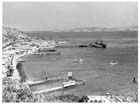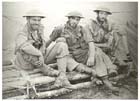The Japanese planned to complete their conquest of Papua and New Guinea by capturing Port Moresby. In early 1942, its garrison comprised about 2,500 Australian soldiers (mostly inexperienced militia) and airmen. Catalina flying boats and Hudson bombers flew reconnaissance and bombing missions, while American B-17 heavy bombers based in Queensland routinely landed to refuel to bomb Rabaul. Japanese aircraft bombed the base regularly but in March Kittyhawk fighters of 75 Squadron RAAF arrived to defend it.
The Japanese attempted a sea attack but this was defeated in the battle of the Coral Sea on 5–8 May 1942. The commander of New Guinea Force, Major General Basil Morris, realised an overland attack might follow but reasoned that “no army could cross the Owen Stanley Range with sufficient equipment to meet a well equipped defending army”.
Base development was stepped-up. Some 3000 American engineers arrived to build airfields, while Australians built infrastructure. The Australian New Guinea Administrative Unit (ANGAU) employed hundreds of Papuan men and women as labourers.
In June 1942, General Douglas MacArthur ordered Morris to secure Buna, on Papua’s north coast. The Papuan Infantry Battalion, comprising 280 poorly trained Papuan troops led by Australian officers and NCOs, crossed the mountains to patrol the coastline. Morris then ordered the 39th Battalion to occupy Kokoda, which had the only airfield between Port Moresby and Buna.
The Kokoda Track was physically and mentally challenging. Tracks were narrow, muddy, hemmed by jungle and, in many stretches, exceptionally steep. For every 1,500 feet men climbed, they descended 1,000 feet before facing up to the next climb. In every valley, streams were crossed on log-and-vine bridges or by wading. After eight days of trekking, men arrived at Kokoda exhausted.
ANGAU employed 800 Papuan men to carry rations from the start of the Kokoda Track to stock staging posts. Another 1500 men from around Buna carried supplies (delivered by small ship) to Kokoda, and more were recruited along the way. Carrying was hard and unpopular, but Papuans had to accept the work because refusal could lead to charges being laid under the territory’s strict indigenous employment laws.
At Rabaul, Major General HORII Tomitaro was ordered to lead his South Seas Detachment over the Owen Stanley Range and take Port Moresby. On 21 July 1942 the leading element landed near Buna. Colonel YOKOYAMA Yosuke then led 900 infantry and combat engineers to Kokoda.
Most of the Papuan troops deserted but some stayed with their Australian leaders. Withdrawing, they linked up with two platoons from Kokoda. The force had no hope of halting the Japanese who were numerically superior, better trained, and more suitably equipped with light weapons and “jungle green” uniforms.
Almost all the carriers from around Buna deserted to return to their families in villages now under Japanese occupation. Papuans in this area were never especially supportive of the Australian administration, and some sought vengeance. Villagers murdered five American airmen who had been shot down and tracked down five Australian soldiers, two male and four female missionaries, and four other civilians including a child who were killed by Japanese troops.
By 30 July, Yokoyama had captured Kokoda. The Australians and some Papuans occupied positions at Deniki. They were tired, worn and hungry, and many were sick. The rest of the 39th Battalion arrived at intervals. The Japanese fired mortars and mountain artillery, a weapon the Australians lacked, and patrols clashed.
The Japanese had brought 1,200 New Guineans from Rabaul and employed villagers to carry rations, equipment and ammunition. The Australians bolstered their carrier lines by shifting hundreds of men from other projects and recruiting more. Morris also secured several Douglas DC-3 transport aircraft from the US Army Air Force to drop supplies.
Both forces awaited reinforcement. HORII deployed the 144th Regiment, keeping his 41st Regiment in reserve. Morris sent another militia battalion, the 53rd, to help Maroubra Force (as the Australian force was known) hold ground until a veteran brigade arrived. The 39th Battalion briefly retook Kokoda but was then pushed back to Isurava.
Morris hoped that Brigadier Arnold Potts’s 21st Brigade could counter-attack. In preparation, DC-3s dropped supplies at Myola, a dry lake-bed near the front, but over 70 per cent of stores fell into the jungle or smashed.
On 28 August, HORII’s 144th Regiment attacked Isurava and Alola, where the 53rd Battalion defended a side-track. Two battalions of the 21st Brigade, the 2/14th and 2/16th, arrived. Though new to jungle warfare, they resisted for four days but HORII then deployed the 41st Regiment and the Australians, outnumbered and outgunned, retreated. Many were cut off; some reached safety but others died in the jungle or were captured and executed.
As fighting intensified, Papuans and New Guineans on both sides worked hard carrying supplies and evacuating casualties. Neither army gave carriers adequate rest, food, shelter or medical care. Many became too ill to continue or deserted. Most of the 900 who stayed with Maroubra Force were re-employed evacuating sick and wounded soldiers. Their dedication and care earned them admiration and the enduring epithet of “Fuzzy Wuzzy Angels”.
The Australians waged a series of delaying actions so that carriers and casualties could keep ahead of the Japanese who were known to kill wounded prisoners. Potts ordered a “scorched earth” policy, with supply dumps destroyed before each retreat. HORII and his staff had assumed that rations would be captured and, when these stocks were destroyed, his men began running out of food. Nonetheless, they pressed on.
Villagers moved clear of the fighting. Huts were wrecked by army occupation, burnt by retreating troops or strafed by aircraft. Australians and Japanese raided gardens, and killed pigs. Areas where units camped were contaminated, as troops suffered diseases including diarrhoea.
Potts tried to make a stand near Efogi but positioned his units badly. Despite tough resistance, the 41st Regiment overran his positions and swept the newly arrived 2/27th Battalion off the track. The 144th Regiment was caught on open ground by Allied aircraft and suffered many casualties from strafing. However, Potts’s exhausted troops now fought only delaying actions.
In early September, the South Seas Detachment reached Ioribaiwa, near the edge of the Owen Stanley Range. It had suffered hundreds of casualties in battle and from sickness; remaining men were weary from the effort and starving because supply lines had broken down, but spirits were buoyed by glimpses of the sea.
MacArthur and the senior Australian general, General Thomas Blamey, feared that Port Moresby might fall. The new commander of New Guinea Force, Lieutenant General Sidney Rowell, reasoned that the Japanese had been weakened by the long advance and the resistance of Maroubra Force and that, unless reinforced, HORII’s force could not overcome the fresh 25th Brigade that was deployed at Ioribaiwa. Despite such confidence, Potts and then Rowell were relieved of their commands.
HORII’s force launched one final attack against the 25th Brigade. Brigadier Eather ordered a tactical withdrawal to the last ridgeline, Imita Ridge. The Japanese pressed against this last defensive line but could advance no further. American landings at Guadalcanal, in the Solomon Islands, had forced the diversion of reinforcements and supplies intended for the final push against Port Moresby. On 14 September 1942, HORII was ordered to withdraw to Buna.
Kokoda (part 1):
 Overview text
Overview text Longer text
Longer text  Images
Images  Readings
Readings  Albert Moore
Albert Moore  Arnold Potts
Arnold Potts  Harvey Blundell
Harvey Blundell  Kiki Baiyane
Kiki Baiyane  Map
MapClick images to enlarge.

AWM 025876

AWM 13290

AWM 013256

AWM 026715
